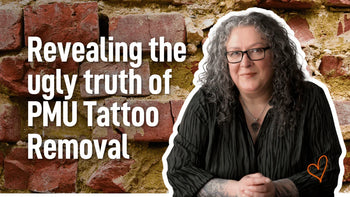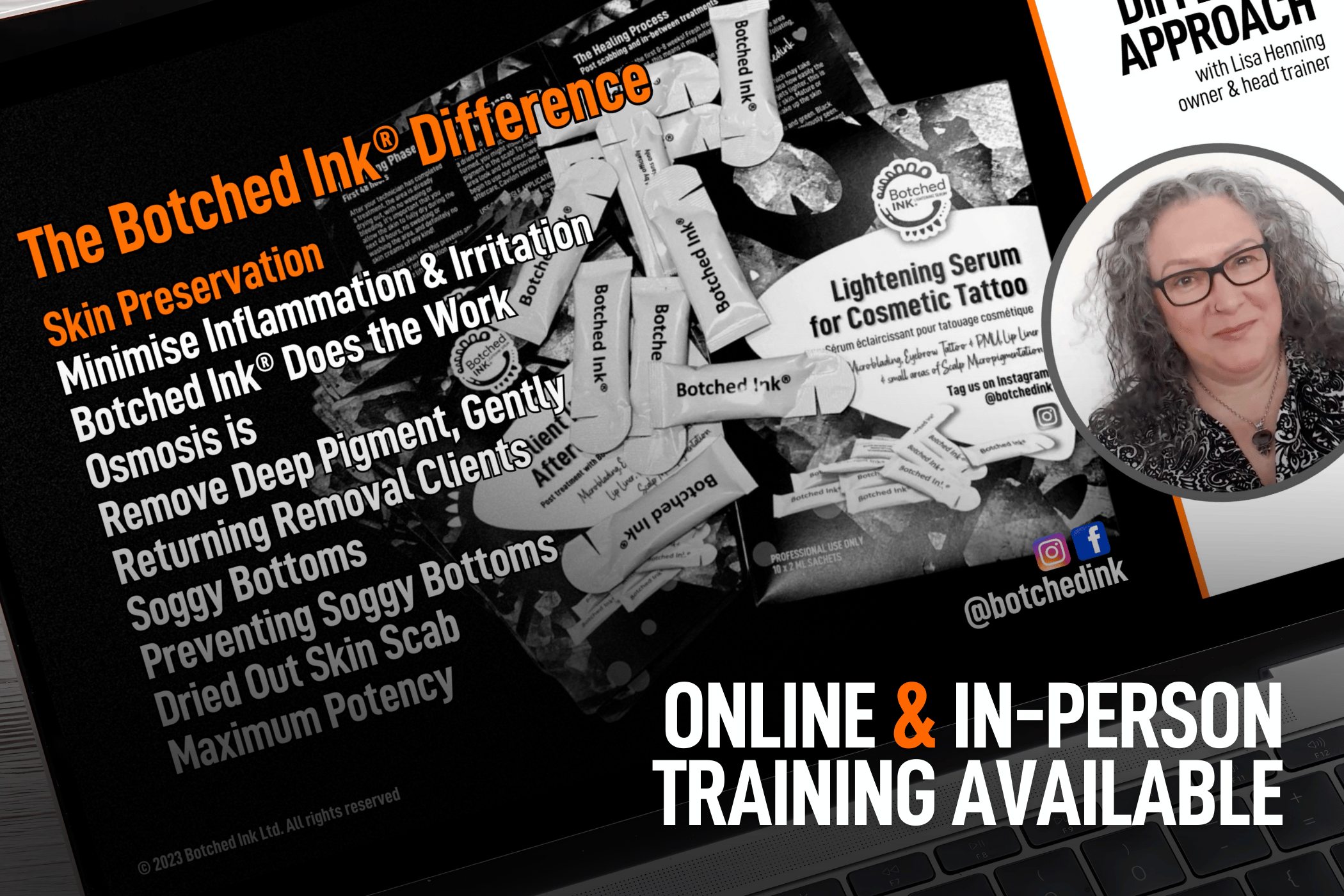🧡 Are you looking to take a permanent makeup removal course?
Botched Ink® training courses and unique saline removal solution for PMU and microblading removal 🤩 We also have a growing team of Approved Trainers to offer our In-person Model Class, which is a great addition for techs with less experience with different needle skills and knowledge
Content
A Personal Guide from an Experienced PMU Artist & Removal Expert
What a wonderful topic this is, and thanks for finding your way to this page on my website! I'm Lisa Henning, the owner and developer of Botched Ink, I use this website to share not only about removal treatments, but our cosmetic tattooing industry in general. My whole philosophy is to share knowledge about permanent makeup pigments and removal with both techs and interested clients, so each can give and receive the best advice and treatment outcomes
I've been in the PMU world since 2012, starting out as a PMU artist when there was little competition from nearby artists, 1rl needles were considered advanced skills, and only iron oxide pigments were used for permanent makeup. Some of the pigment info in this article, I wish someone had shared with me during my early years!
I've also been removing pigments since 2013, starting with salt and saline, then on to developing Botched Ink back in 2018. Since understanding how to remove PMU pigments, I've become even more of an expert in permanent makeup pigments. Not the kind of knowledge you'd learn from a pigment manufacturer or a colour and correction expert, but the basic knowledge every tech should understand about the permanent makeup pigments artists use every working day!
Today, I'd like to share some key insights about permanent and semi permanent makeup pigments, drawing from my extensive experience as a PMU artist and educator within this industry

'What's in your Pigment' Masterclass
Just like beauty creams and serums, certain ingredients get highlighted, like 1% hyaluronic acid or retinol, but what makes up the rest of the ingredients, known as the cosmetic base. And what effect do the base ingredients have on how the cream feels, how easily it’s absorbed, and in to which layers of the skin
Look at your tattoo pigment bottles, you’re likely to see quite a list of ingredients. How do different types of carrier fluid ingredients affect the pigment powder, and how does this then affects tattooing, healing, retention and removal? Enrol on my course, and you'll find out!
Understanding Permanent and Semi Permanent Makeup Pigments
The PMU pigments we use to enhance and create beautiful eyebrows, lips and eyes come in an extensive range of shades and consistencies . Pigments are often referred to as permanent makeup inks, and unlike traditional makeup, PMU pigments are implanted into the skin, providing a more durable solution that doesn't wash off each day
Some give long lasting results, others are designed to fade, this is the consideration and confusion between permanent makeup pigments and semi permanent makeup pigments. When we know the type of pigments we're working with, we can choose the best option for each client, keeping in mind the client's own personal preferences
Yes tattooing fashion shapes with longer lasting pigments is a wonderful idea in the short term, by that I mean 2-5 years, but what happens when our style becomes a little more natural, or fashions change. Thankfully, this is where Botched Ink can help, with our gentle removal solution, and if brows are more dense and saturated, combining with laser when needed - Always Botched Ink first!
Comparison with Hair Colouring, Permanent and Semi-Permanent
Pigment, whether it's considered permanent or semi permanent, has made a long term change to the skin. The term semi-permanent is not one that's used much anymore, due to the confusion it's caused over the years - Not weeks!
Permanent Hair Colour: These long-lasting hair colors contain pigment molecules and extra ingredients that penetrate deep into the hair shaft. This means they cope with multiple hair washes, resulting in a color that remains vibrant for a longer period. Sun exposure in the early days can permanently change the colour, so can other environmental exposures. Over time, as hair grows and the colour fades, you'll still see a permanent change has been made to the hair follicle
Semi-Permanent Hair Colour: On the other hand, hair colors that fade quickly usually contain pigment molecules that sit more on the surface of the hair. These molecules are easily washed away with shampooing and exposure to sunlight and other environmental factors, causing the colour to fade faster. Unless hair follicles are particularly absorbent, or light in colour, semi-permanent hair colours visibly fade away, as no pigment molecules got in the hair follicle
If carried out by a skilled PMU artist, the permanent makeup pigments heal as superficially in the skin as befits the style of brow and desired results. Permanent makeup pigment still can't be washed away, and even when they fade, it's only the visible colour that's faded, the implanted pigment powders remain in the skin forever
That's why old faded work can look so faded, yet there's no more room in the skin for another touch up session, or any colour correction! It's educating your eye, and asking you client questions about how many treatments they could have had over the years. Asking how their brows looked when they were first worked, and then covered over the years, helps you learn more about their tattoo history

Permanent Makeup Pigment Brands
Most PMU artists have heard of Perma Blend and Li Pigments, but there's other brands available. I've tried to include worldwide manufacturers and their websites, some also have an online shop. But this isn't a full list of all the pigment brands available around the world, any many are manufactured by these companies
What's in Your Permanent Makeup Pigments?
It's important to understanding the composition of the pigments used, not just whether the pigment is organic, inorganic pigments or a hybrid mix of the two. It's easy just to look at organic pigment being known for its vibrant colors, and inorganic pigments being more muted, but there's more to pigments than just the pigmented powder colours
While other courses about pigments focus on colour theory, iron oxide, organic and hybrid pigments, colour corrections and mastering your skills as a technician, I wrote a Masterclass about what else is in your pigment bottles – The Elephant in the Room!
A Masterclass on Carrier Fluid Ingredients
Our "What's In Your Pigment?" masterclass explores the different ingredients in pigment carrier fluids, and their role in PMU treatments. Carrier fluids are the liquid part of the pigment in each bottle, making sure the pigment powders are evenly distributed and absorbed by the skin, this leads to consistent and predictable healed results. Ingredients are typically labelled on the bottle, or come with the bottle, but for others you need to research a little more
Some carrier ingredients also changing how pigment looks in the skin once it's healed, more than just considering whether the pigment is organic, inorganic or hybrid. This is why some pigments heal looking soft and powdery, while others heal looking more fresh, just think about face makeup for a second, a translucent glossy lip tint, a creamy lipstick and a lip liner pencil can all have the same colour and shades of pigment powder, but they're all different textures
Permanent Makeup Inks or Pigment?
It's true that in recent years we can no longer say to a client that the healed colour will fade by 50%, as with some there's much less fading once healed. Do you know the fade on heal factor of your pigments? You'll find it's too easy to implant more pigment than you need to
This is the first and only Masterclass on carrier fluid ingredients. Discover how ingredients such as glycerin, polysorbate 20, propylene glycol, rosin, and PVP can affect tattooing, healing, retention, and the removal processes. Topics covered in my online Masterclass are: Introduction - The Elephant in the Room - Carrier Fluid Ingredients - Vegan Friendly - Cruelty Free - Consequences for Removal - Conclusion
Are we using inks or pigments? That's your call my friend!

"That's why old faded work can look so faded, yet there's no more room in the skin for another touch up session, or any colour correction!"
Choosing the Right Pigments for Your Clients
As PMU experts, it's essential to choose pigments that will best meet your clients' needs. Factors such as skin tone, desired results, bold or more natural. When working on the face, it's important to select shades that complement the client's natural hair color and skin tone, creating a beautiful natural look
When selecting pigments for lips, vibrant and organic pigments are often the go-to choice, as they provide the bold, rich colors that clients desire. Additionally, using high-quality pigments can ensure that the results are not only stunning but also long lasting. Whilst some range of pigments are at competitive prices, allowing artists to find the perfect match for their clients without breaking the bank, others are more expensive
When you stock up and buy pigments, it's worth knowing that after opening, a bottle is only suitable to use for 12 months. This is because the preservatives in each bottle are designed to be effective for a certain amount of time after exposure to air
Pigment Removal: A Second Chance for Perfect Results
Despite the best efforts of artists, there are times when a client may wish to remove or alter their PMU. This is where my expertise as a pigment removal specialist comes into play. At Botched Ink, I've developed a gentle saline removal solution, and a comprehensive training course. We're building strong team of correction and removal specialists, each giving clients a fresh start and the opportunity to achieve their desired results in future work
Botched Ink is designed to be gentle on the skin, while effectively lifting up and our the unwanted pigments. This approach minimizes the risk of scarring and other complications, allowing clients to confidently undergo further treatments if desired

Final Thoughts
Permanent makeup pigments have transformed the beauty industry, offering clients a way to enhance their natural appearance with long-lasting results. As an experienced PMU artist and pigment removal specialist, I've seen firsthand the difference the pigments we use can have on a client's confidence and satisfaction. By choosing the right pigments, prioritizing safety, and staying informed about industry advancements, we can continue to work together to provide exceptional results for our clients
But these long lasting pigments are here to stay, quite literally. There is now a movement being headed up by more experienced PMU astrists, that these pigments should be considered advanced, and left to the experienced hand, to create face enhancing beautiful work. Long lasting pigments are not for the novices, they implant very easily, and by definition, last a long time. Needle skills and understanding of the skin tone and type, play an huge part in offering the best results to clients
Thank you for reading this post, I hope you’ve enjoyed some of my insights and inspiration for your own work or treatments. Remember, quality pigments and experienced artistry lead to beautiful results that last, so happy tattooing





